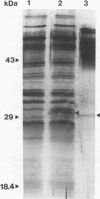Abstract
Arcanobacterium haemolyticum, a pathogen of the human upper respiratory tract and other systems, has been reported to produce soluble toxins, including a phospholipase D (PLD). We confirmed production of PLD by this organism and cloned and sequenced pld. Arcanobacterial PLD (PLD-A) was found to be a protein of approximately 31.5 kDa with a pI of approximately 9.4. Cosmid cloning, followed by subcloning into phagemid pBluescriptIISK+, yielded Escherichia coli(pAh140), a recombinant with a gene product corresponding to PLD-A. Evidence of PLD activity was found by three assays in supernatant fluid of cultures of E. coli(pAh140) and A. haemolyticum, but not in E. coli(pBluescriptIISK+). Experiments to determine if this protein was secreted were not conducted, but previous work with PLD from Corynebacterium pseudotuberculosis suggested that the presence of the enzyme in culture supernatant fluids was due to lysis of E. coli rather than to active transport. Antibodies in polyclonal sera from goats immunized with native or recombinant PLD-A neutralized native and recombinant PLD-A activity, and antibodies against native or recombinant PLD from C. pseudotuberculosis (PLD-P) partially neutralized native and recombinant PLD-A. Antibodies prepared against recombinant PLD-A labelled both recombinant and native PLD-A in Western blots (immunoblots) and dot blots, but antibodies against PLD-P did not. Sequencing of the insert in pAh140 revealed an open reading frame of 930 bp coding for 309 amino acids, including a putative signal sequence of 26 amino acids (3.2 kDa, determined on the basis of homology with the 24-amino-acid signal sequence of pld from C. pseudotuberculosis bv. ovis) and the mature PLD protein (31.5 kDa). Sequence comparisons of coding regions revealed 65% DNA homology with pld genes from C. pseudotuberculosis and Corynebacterium ulcerans. Comparison of amino acid sequences revealed 64% homology of PLD-A both with PLD-P and with PLD produced by C. ulcerans.
Full text
PDF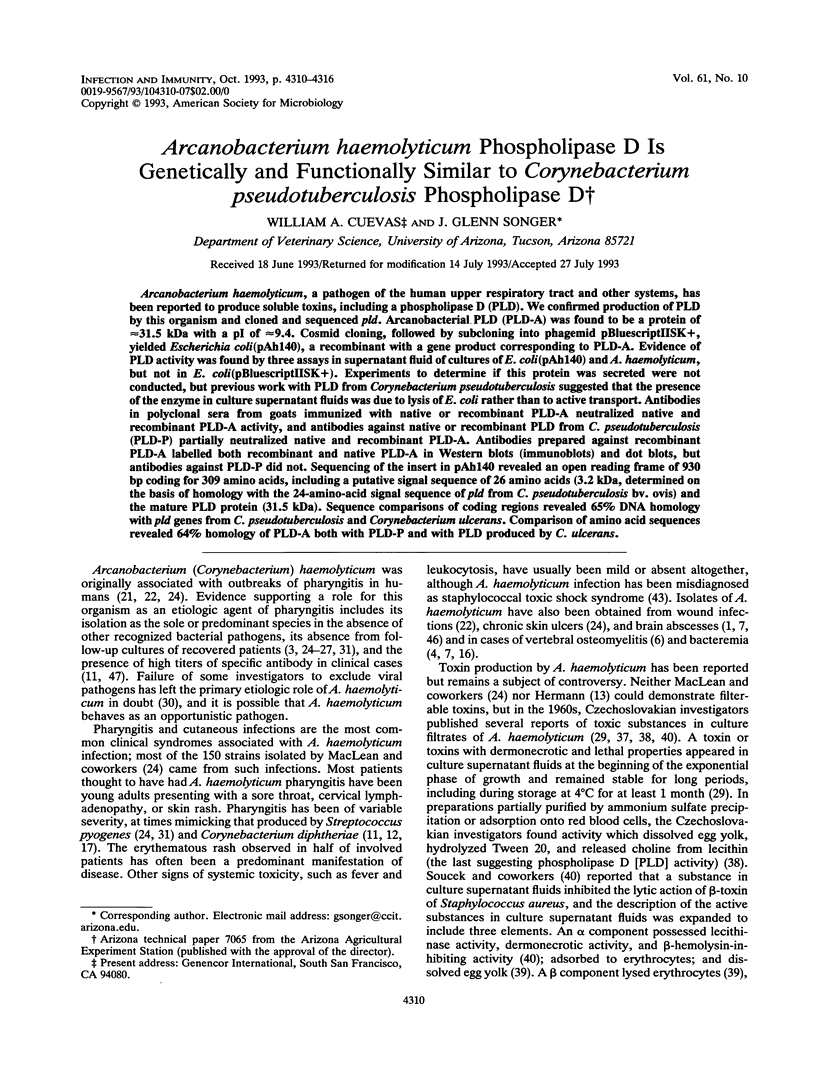
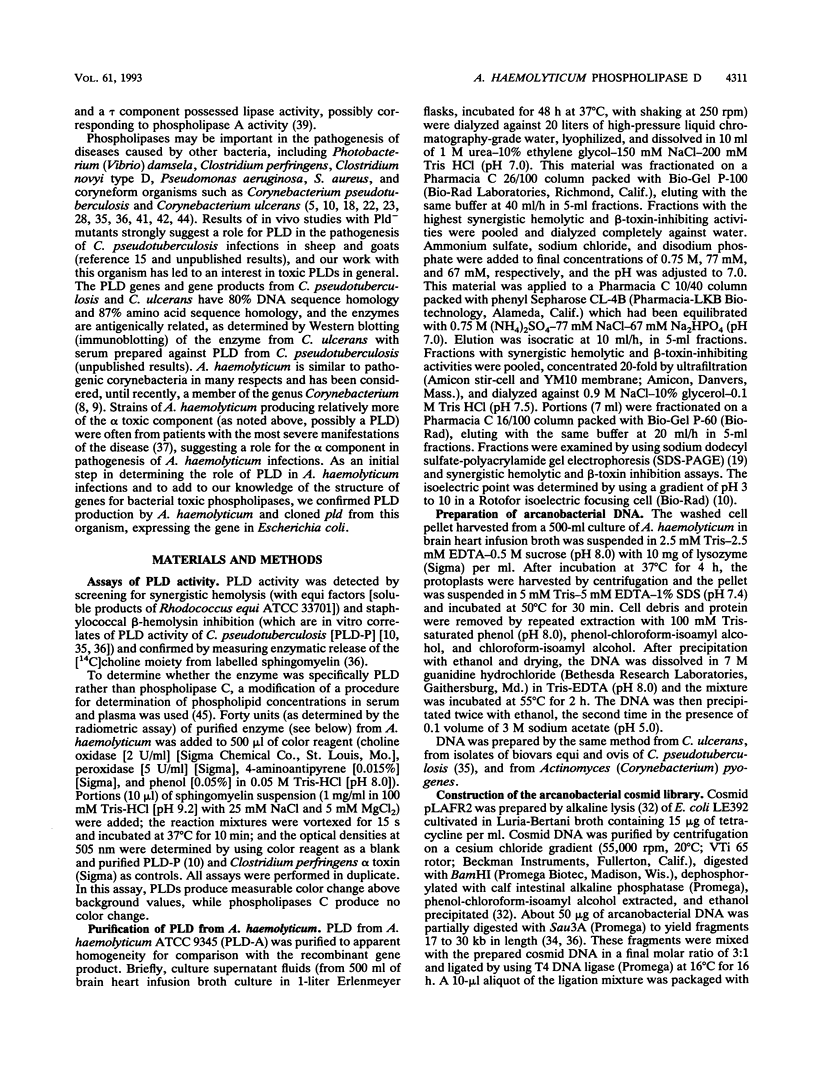
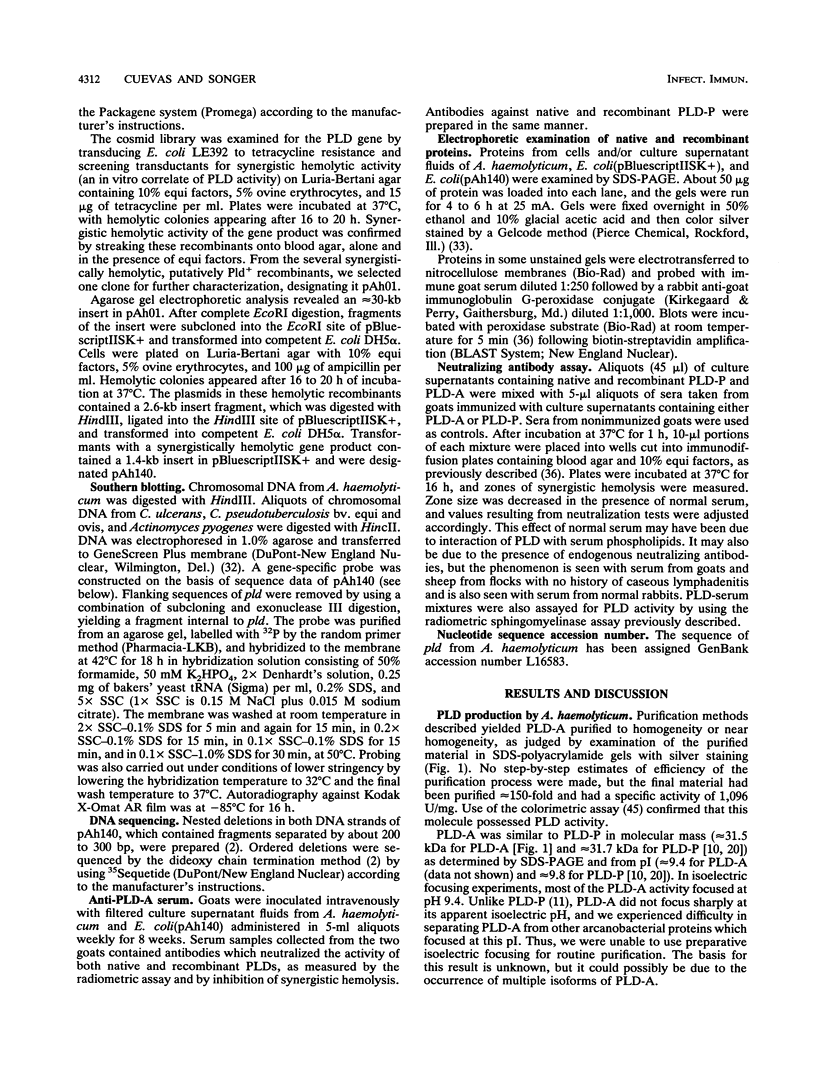

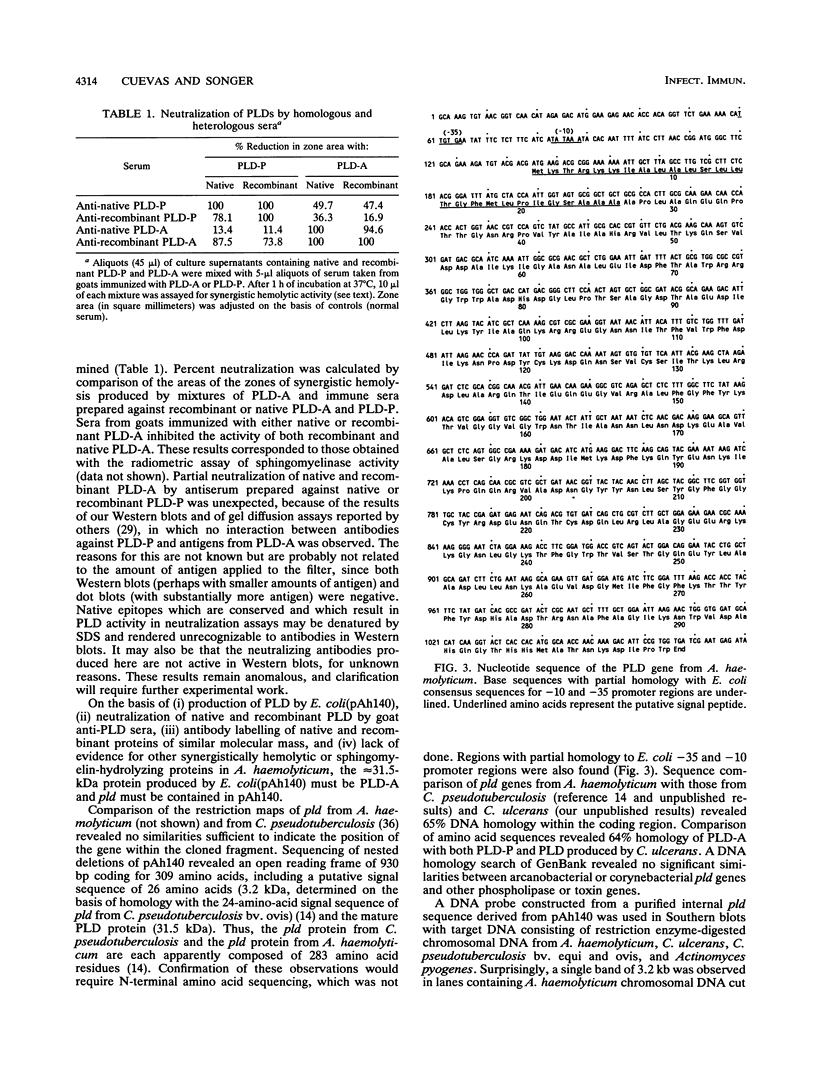
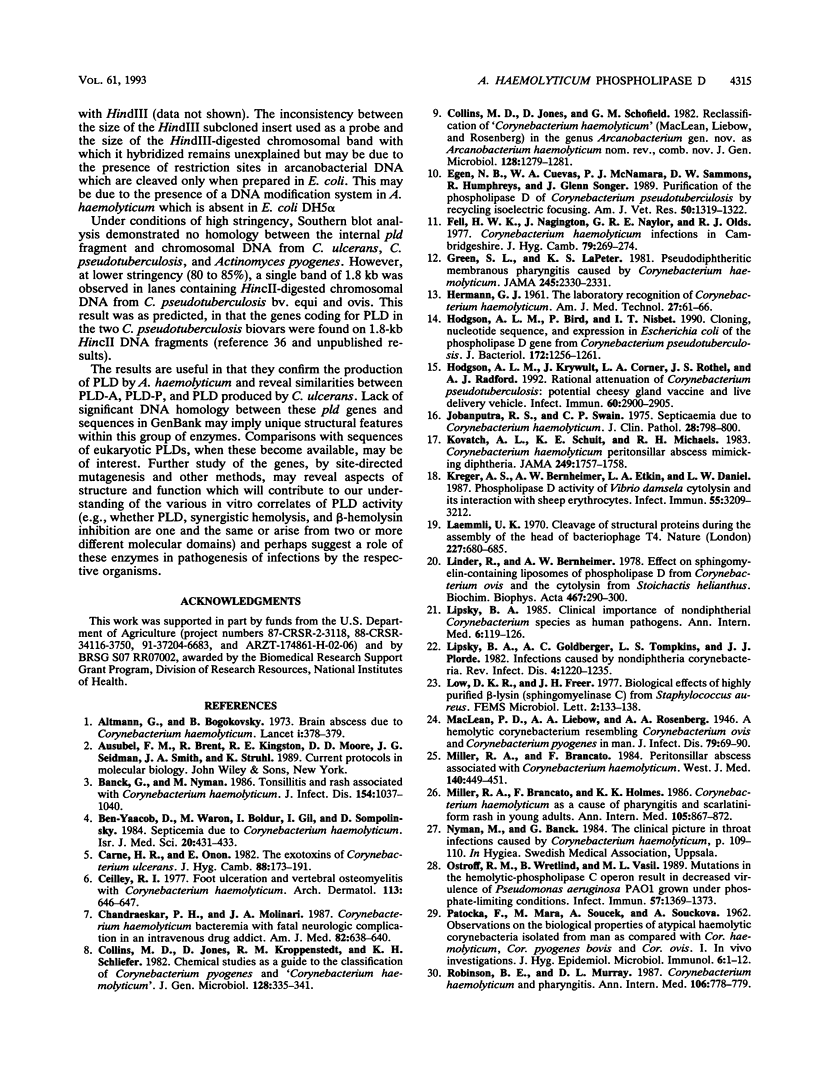
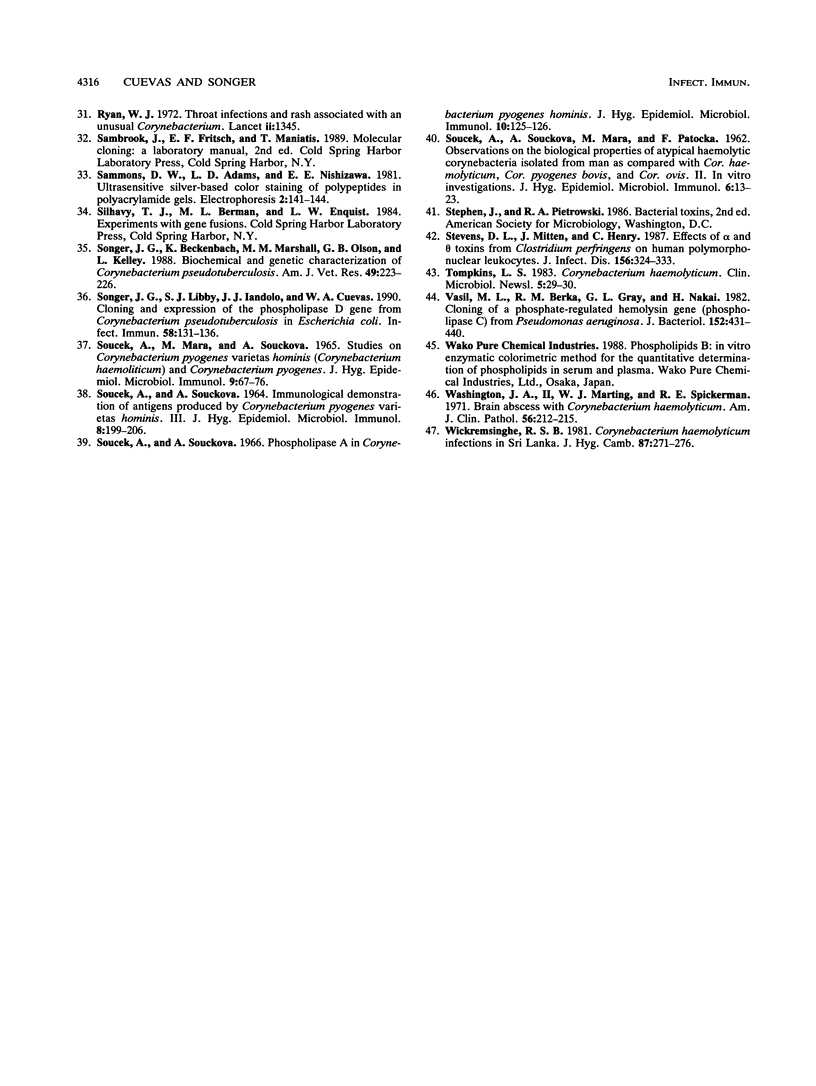
Images in this article
Selected References
These references are in PubMed. This may not be the complete list of references from this article.
- Altmann G., Bogokovsky B. Brain abscess due to Corynebacterium haemolyticum. Lancet. 1973 Feb 17;1(7799):378–379. doi: 10.1016/s0140-6736(73)90177-3. [DOI] [PubMed] [Google Scholar]
- Banck G., Nyman M. Tonsillitis and rash associated with Corynebacterium haemolyticum. J Infect Dis. 1986 Dec;154(6):1037–1040. doi: 10.1093/infdis/154.6.1037. [DOI] [PubMed] [Google Scholar]
- Ben-Yaacob D., Waron M., Boldur I., Gil I., Sompolinsky D. Septicemia due to Corynebacterium haemolyticum. Isr J Med Sci. 1984 May;20(5):431–433. [PubMed] [Google Scholar]
- Carne H. R., Onon E. O. The exotoxins of Corynebacterium ulcerans. J Hyg (Lond) 1982 Apr;88(2):173–191. doi: 10.1017/s0022172400070054. [DOI] [PMC free article] [PubMed] [Google Scholar]
- Ceilley R. I. Foot ulceration and vertebral osteomyelitis with Corynebacterium haemolyticum. Arch Dermatol. 1977 May;113(5):646–647. [PubMed] [Google Scholar]
- Chandrasekar P. H., Molinari J. A. Corynebacterium hemolyticum bacteremia with fatal neurologic complication in an intravenous drug addict. Am J Med. 1987 Mar 23;82(3 Spec No):638–640. doi: 10.1016/0002-9343(87)90114-8. [DOI] [PubMed] [Google Scholar]
- Collins M. D., Jones D., Kroppenstedt R. M., Schleifer K. H. Chemical studies as a guide to the classification of Corynebacterium pyogenes and "Corynebacterium haemolyticum". J Gen Microbiol. 1982 Feb;128(2):335–341. doi: 10.1099/00221287-128-2-335. [DOI] [PubMed] [Google Scholar]
- Collins M. D., Jones D., Schofield G. M. Reclassification of 'Corynebacterium haemolyticum' (MacLean, Liebow & Rosenberg) in the genus Arcanobacterium gen.nov. as Arcanobacterium haemolyticum nom.rev., comb.nov. J Gen Microbiol. 1982 Jun;128(6):1279–1281. doi: 10.1099/00221287-128-6-1279. [DOI] [PubMed] [Google Scholar]
- Egen N. B., Cuevas W. A., McNamara P. J., Sammons D. W., Humphreys R., Songer J. G. Purification of the phospholipase D of Corynebacterium pseudotuberculosis by recycling isoelectric focusing. Am J Vet Res. 1989 Aug;50(8):1319–1322. [PubMed] [Google Scholar]
- Fell H. W., Nagington J., Naylor G. R., Olds R. J. Corynebacterium haemolyticum infections in Cambridgeshire. J Hyg (Lond) 1977 Oct;79(2):269–274. doi: 10.1017/s0022172400053080. [DOI] [PMC free article] [PubMed] [Google Scholar]
- Green S. L., LaPeter K. S. Pseudodiphtheritic membranous pharyngitis caused by Corynebacterium hemolyticum. JAMA. 1981 Jun 12;245(22):2330–2331. [PubMed] [Google Scholar]
- HERMANN G. J. The laboratory recognition of Corynebacterium hemolyticum. Am J Med Technol. 1961 Jan-Feb;27:61–66. [PubMed] [Google Scholar]
- Hodgson A. L., Bird P., Nisbet I. T. Cloning, nucleotide sequence, and expression in Escherichia coli of the phospholipase D gene from Corynebacterium pseudotuberculosis. J Bacteriol. 1990 Mar;172(3):1256–1261. doi: 10.1128/jb.172.3.1256-1261.1990. [DOI] [PMC free article] [PubMed] [Google Scholar]
- Hodgson A. L., Krywult J., Corner L. A., Rothel J. S., Radford A. J. Rational attenuation of Corynebacterium pseudotuberculosis: potential cheesy gland vaccine and live delivery vehicle. Infect Immun. 1992 Jul;60(7):2900–2905. doi: 10.1128/iai.60.7.2900-2905.1992. [DOI] [PMC free article] [PubMed] [Google Scholar]
- Jobanputra R. S., Swain C. P. Septicaemia due to Corynebacterium haemolyticum. J Clin Pathol. 1975 Oct;28(10):798–800. doi: 10.1136/jcp.28.10.798. [DOI] [PMC free article] [PubMed] [Google Scholar]
- Kovatch A. L., Schuit K. E., Michaels R. H. Corynebacterium hemolyticum peritonsillar abscess mimicking diphtheria. JAMA. 1983 Apr 1;249(13):1757–1758. [PubMed] [Google Scholar]
- Kreger A. S., Bernheimer A. W., Etkin L. A., Daniel L. W. Phospholipase D activity of Vibrio damsela cytolysin and its interaction with sheep erythrocytes. Infect Immun. 1987 Dec;55(12):3209–3212. doi: 10.1128/iai.55.12.3209-3212.1987. [DOI] [PMC free article] [PubMed] [Google Scholar]
- Laemmli U. K. Cleavage of structural proteins during the assembly of the head of bacteriophage T4. Nature. 1970 Aug 15;227(5259):680–685. doi: 10.1038/227680a0. [DOI] [PubMed] [Google Scholar]
- Linder R., Bernheimer A. W., Kim K. S. Interaction between sphingomyelin and a cytolysin from the sea anemone Stoichactis helianthus. Biochim Biophys Acta. 1977 Jun 16;467(3):290–300. doi: 10.1016/0005-2736(77)90306-6. [DOI] [PubMed] [Google Scholar]
- Lipsky B. A., Goldberger A. C., Tompkins L. S., Plorde J. J. Infections caused by nondiphtheria corynebacteria. Rev Infect Dis. 1982 Nov-Dec;4(6):1220–1235. doi: 10.1093/clinids/4.6.1220. [DOI] [PubMed] [Google Scholar]
- Miller R. A., Brancato F., Holmes K. K. Corynebacterium hemolyticum as a cause of pharyngitis and scarlatiniform rash in young adults. Ann Intern Med. 1986 Dec;105(6):867–872. doi: 10.7326/0003-4819-105-6-867. [DOI] [PubMed] [Google Scholar]
- Miller R. A., Brancato F. Peritonsillar abscess associated with Corynebacterium hemolyticum. West J Med. 1984 Mar;140(3):449–451. [PMC free article] [PubMed] [Google Scholar]
- Ostroff R. M., Wretlind B., Vasil M. L. Mutations in the hemolytic-phospholipase C operon result in decreased virulence of Pseudomonas aeruginosa PAO1 grown under phosphate-limiting conditions. Infect Immun. 1989 May;57(5):1369–1373. doi: 10.1128/iai.57.5.1369-1373.1989. [DOI] [PMC free article] [PubMed] [Google Scholar]
- PATOCKA F., MARA M., SOUCEK A., SOUCKOVA A. Observations on the biological properties of atypical haemolytic Corynebacteria isolated from man as compared with Cor, haemolyticum, Cor. Pyogenes bovis and Cor. ovis. I. In vivo investigations. J Hyg Epidemiol Microbiol Immunol. 1962;6:1–12. [PubMed] [Google Scholar]
- Robinson B. E., Murray D. L. Corynebacterium hemolyticum and pharyngitis. Ann Intern Med. 1987 May;106(5):778–779. doi: 10.7326/0003-4819-106-5-778_3. [DOI] [PubMed] [Google Scholar]
- Ryan W. J. Throat infection and rash associated with an unusual Corynebacterium. Lancet. 1972 Dec 23;2(7791):1345–1347. doi: 10.1016/s0140-6736(72)92782-1. [DOI] [PubMed] [Google Scholar]
- SOUCEK A., MARA M., SOUCKOVA A. STUDIES ON CORYNEBACTERIUM PYOGENES VARIETAS HOMINIS. IV. COMPARISON OF ACTIVE COMPONENTS IN CORYNEBACTERIUM PYOGENES VARIETAS HOMINIS (CORYNEBACTERIUM HAEMOLITICUM) AND CORYNEBACTERIUM PYOGENES. J Hyg Epidemiol Microbiol Immunol. 1965;9:67–76. [PubMed] [Google Scholar]
- SOUCEK A., SOUCKOVA A. IMMUNOLOGICAL DEMONSTRATION OF ANTIGENS PRODUCED BY CORYNEBACTERIUM PYOGENES VARIETAS HOMINIS. 3. J Hyg Epidemiol Microbiol Immunol. 1964;8:199–206. [PubMed] [Google Scholar]
- SOUCEK A., SOUCKOVA A., MARA M., PATOCKA F. Observations on the biological properties of atypical haemolytic Corynebacteria isolated from man as compared with Cor. haemolyticum, Cor. pyogenes bovis and Cor. ovis. II. In vitro investigations. J Hyg Epidemiol Microbiol Immunol. 1962;6:13–23. [PubMed] [Google Scholar]
- Songer J. G., Beckenbach K., Marshall M. M., Olson G. B., Kelley L. Biochemical and genetic characterization of Corynebacterium pseudotuberculosis. Am J Vet Res. 1988 Feb;49(2):223–226. [PubMed] [Google Scholar]
- Songer J. G., Libby S. J., Iandolo J. J., Cuevas W. A. Cloning and expression of the phospholipase D gene from Corynebacterium pseudotuberculosis in Escherichia coli. Infect Immun. 1990 Jan;58(1):131–136. doi: 10.1128/iai.58.1.131-136.1990. [DOI] [PMC free article] [PubMed] [Google Scholar]
- Soucek A., Soucková A. Phospholipase A in Corynebacterium pyogenes hominis. J Hyg Epidemiol Microbiol Immunol. 1966;10(1):125–126. [PubMed] [Google Scholar]
- Stevens D. L., Mitten J., Henry C. Effects of alpha and theta toxins from Clostridium perfringens on human polymorphonuclear leukocytes. J Infect Dis. 1987 Aug;156(2):324–333. doi: 10.1093/infdis/156.2.324. [DOI] [PubMed] [Google Scholar]
- Vasil M. L., Berka R. M., Gray G. L., Nakai H. Cloning of a phosphate-regulated hemolysin gene (phospholipase C) from Pseudomonas aeruginosa. J Bacteriol. 1982 Oct;152(1):431–440. doi: 10.1128/jb.152.1.431-440.1982. [DOI] [PMC free article] [PubMed] [Google Scholar]
- Washington J. A., Martin W. J., Spiekerman R. E. Brain abscess with Corynebacterium hemolyticum: report of a case. Am J Clin Pathol. 1971 Aug;56(2):212–215. doi: 10.1093/ajcp/56.2.212. [DOI] [PubMed] [Google Scholar]
- Wickremesinghe R. S. Corynebacterium haemolyticum infections in Sri Lanka. J Hyg (Lond) 1981 Oct;87(2):271–276. doi: 10.1017/s0022172400069485. [DOI] [PMC free article] [PubMed] [Google Scholar]




